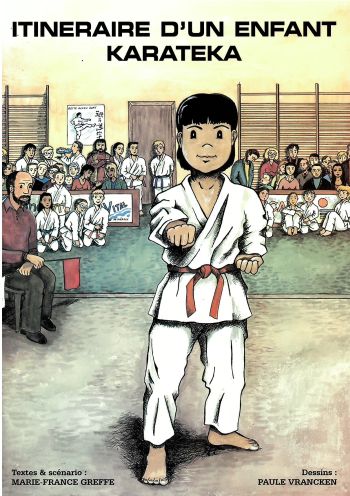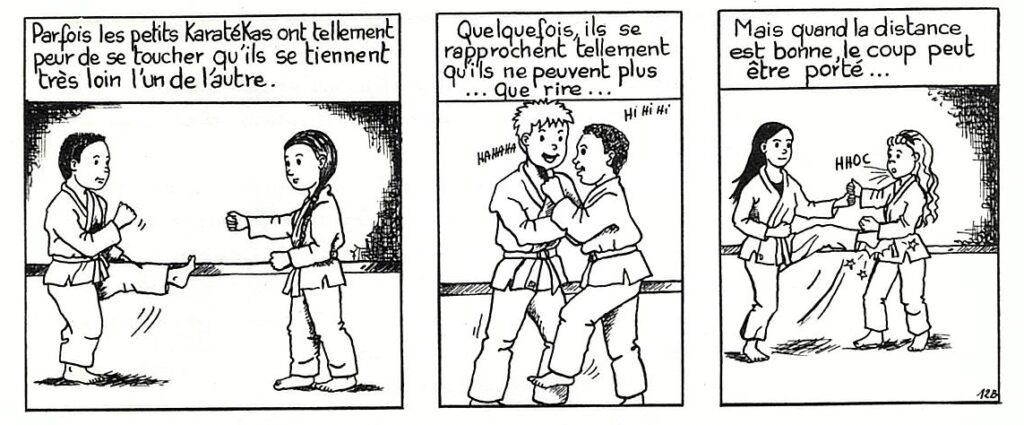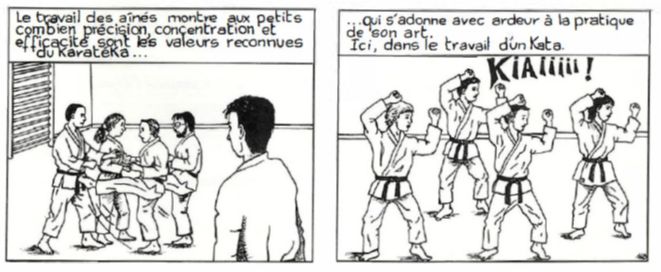Itinerary of a Karateka child – Marie-France Greffe and Paule Vrancken

Back in 1997, Marie-France Greffe, a black belt in Wado-Ryu karate, teamed up with her club colleague Paule Vrancken to create an illustrated strip about karate for children.
In an illustrated strip, the drawings are of course important, and children will be able to relate to them because they capture the atmosphere of a karate dojo where children train.
But the story told in this illustrated strip shows us what karate can teach young children and pre-adolescents: courage, dignity, knowledge of one’s limits but also of one’s emotions, the joy of succeeding, discipline, respect for others, participation in a group, pride in passing an exam…
As well as the story told in illustrated strip form, Marie-France adds a real karate manual in a language that is accessible to children, but whose content can enrich the knowledge of karateka who have already been practicing for a few years! I urge everyone, whatever their rank, to read this illustrated strip carefully.
Marie-France introduces her illustrated strip with the following text:
“I’ve been teaching karate to children for ten years now.
Practicing the martial art has taught me a lot about myself and about life. I try to share this with the little karatekas. Their thirst for knowledge, their ability to learn respect for others and their desire to acquire their dignity as human beings amaze me and encourage me to continue on my own path.
Somehow, I love these little ones.
Two years ago, Paule joined us. She’s a young lady who I think has found a new direction in life through karate. I asked her to come and help me teach the little ones and she’s been with us ever since.
She’s an artist. She draws and paints. She suggested we combine our talents. I wrote the story, she visualised it and then reproduced it, with her magic pencil and brushes… “
At the end of the illustrated strip, Marie-France quotes: “Karate is a never-ending quest that must be constantly renewed, because the practice of this art is never completely acquired. Karateka are always learning and improving. Their knowledge is always being challenged.”
Something to think about for a long time…
I would like to thank Marie-France for her agreement to place the illustrated strip “Itinéraire d’un enfant karateka” in its entirety on our website dedicated to Kamigaito Yoshikazu and his students, including Marie-France Greffe.


Loose reflections on Budo, Karatedo and Wado Ryu karate in particular (3) End – Jan Houblon
Following on from the second part of these reflections, I would like to share with you my current
views on the subject of kumite in Wado Ryu karate. (In which I wish to emphasise again that this is
a personal view at this point in my life.)
We cannot, in my opinion, get away from stating that all solo exercises (kata, kihon waza, physical
conditioning etc) are in function of kumite, and it was this latter element in particular that
maximised its appeal to Westerners in the 1970s. This resulted in the fact that today ‘sport
karate’ and multi-style competitions are the predominant focus within Western karate.
(Incidentally, it is an identical phenomenon that occurred in Judo and kendo, except perhaps that
most kendo organisations continued to place particular value on the great tradition of mental
attitude)…
Loose reflections on Budo, Karatedo and Wado Ryu karate in particular (2) – Jan Houblon
I started my Wado Ryu path in 1975. Subtract a few years when I was away
from the ‘Wado inner Circle’ due to health and family reasons, then I
may/can still look back on a good 35 years of Wado karate practice (I admit
it would look a bit more illustrative if I could express my past practice in
weeks or hours )
Anyway, during its roughly first ten years, I and other contemporaries, had
the good fortune of receiving instruction from a real Japanese sensei you all
well known as the late venerable sensei Yoshikazu Kamigaïto.
Weekly (sometimes even 2 or 3 times a week), we were therefore put
through a Japanese modulated training programme in which we were
prepared from the lowest beginner level to the coveted dan grade (which I
myself earned after roughly five years of dedicated practice). Personally, I
practised -certainly for the first 10 years- about six to eight hours a week,
which was my physical limit…
Loose reflections on Budo, Karatedo and Wado Ryu karate in particular (1) – Jan Houblon
Because I have always been of the opinion that a budo practitioner -in addition to his daily practice- should constantly reflect on that same practice and subject it to critical reflection, I am making you part of some of these reflections. The reader should take note of these in the full knowledge that these are subjective views on an occupation to which I have always devoted myself with heart and soul.
On the principle of Shu Ha Ri and my personal adaptation to it:
Click on the link to go to the article…
KIHON NO KATA and KETTE KIHON NO KATA
Foreword
KIHON NO KATA, also called KIHON NO KATA N°1 (WADO-RYU) is a basic Kata taught to us by Yoshikazu Kamigaito Sensei in the years 1970-1990 in Belgium. (More information about Yoshikazu Kamigaito Sensei on the website https://wado-kamigaito-ryu.be/en/yoshikazu-kamigaito-sensei-english/)
This apparently very simple Kata is initially intended to be taught to beginners in Wado-Ryu Karate.
After the starting Yoi position, only the Zen Kutsu Dachi position is used.
There are three techniques used in this Kihon No Kata N°1, namely, Junzuki Chudan, Gedan Barai and Jodan Age Uke. For more details on these techniques, I refer you to the Wado-Ryu Karate Manual for Instructors – Volume 2 “KIHON” written by Yoshikazu Kamigaito Sensei (https://wado-kamigaito-ryu.be/en/yoshikazu-kamigaito-sensei-english/wado-ryu-karate-manual-for-monitor-yoshikazu-kamigaito-sensei/ )
In addition to these three techniques to be worked on during the Kata, there are two important aspects to develop:
1. Body rotations with change of direction and execution of Gedan Barai.
Here, the greatest possible range of rotation of the hips should be sought and therefore, in the first movement for example, the placement of the left foot should be in the right place before the body and hips change attitude or direction. Only the left arm will be placed with the fist a little lower than the right shoulder, back of the fist downwards…
You can download the full description of Kihon No Kata and Kette Kihon No Kata by clicking on the link below: